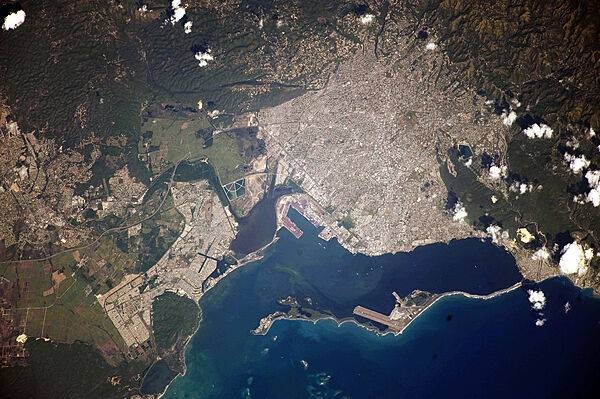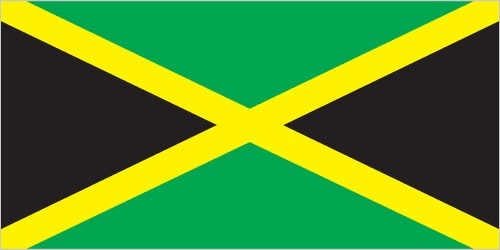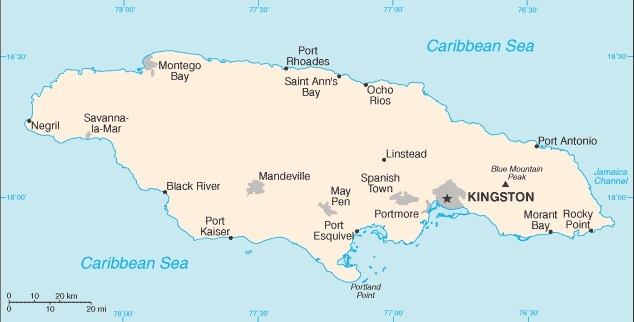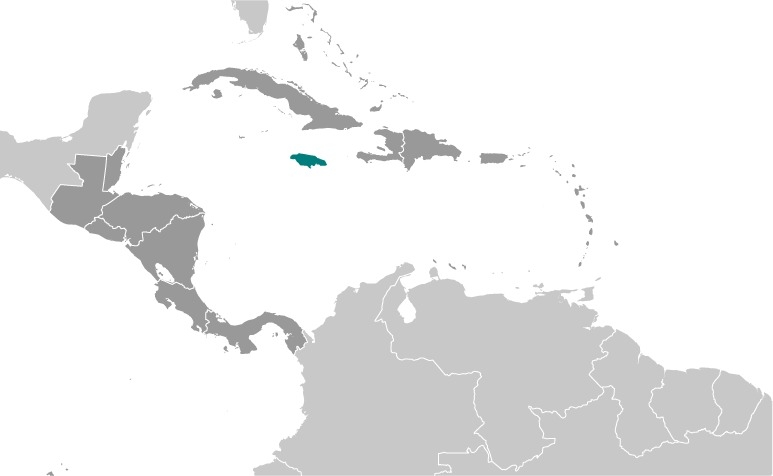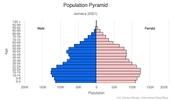Introduction
Background
The island - discovered by Christopher COLUMBUS in 1494 - was settled by the Spanish early in the 16th century. The native Taino, who had inhabited Jamaica for centuries, were gradually exterminated and replaced by African slaves. England seized the island in 1655 and established a plantation economy based on sugar, cocoa, and coffee. The abolition of slavery in 1834 freed a quarter million slaves, many of whom became small farmers. Jamaica gradually increased its independence from Britain. In 1958 it joined other British Caribbean colonies in forming the Federation of the West Indies. Jamaica withdrew from the Federation in 1961 and gained full independence in 1962. Deteriorating economic conditions during the 1970s led to recurrent violence as rival gangs affiliated with the major political parties evolved into powerful organized crime networks involved in international drug smuggling and money laundering. Violent crime, drug trafficking, and poverty pose significant challenges to the government today. Nonetheless, many rural and resort areas remain relatively safe and contribute substantially to the economy.
Visit the Definitions and Notes page to view a description of each topic.
Geography
Location
Caribbean, island in the Caribbean Sea, south of Cuba
Geographic coordinates
18 15 N, 77 30 W
Map references
Central America and the Caribbean
Land boundaries
total: 0 km
Coastline
1,022 km
Maritime claims
territorial sea: 12 nm
contiguous zone: 24 nm
exclusive economic zone: 200 nm
continental shelf: 200 nm or to edge of the continental margin
measured from claimed archipelagic straight baselines
Climate
tropical; hot, humid; temperate interior
Terrain
mostly mountains, with narrow, discontinuous coastal plain
Elevation
highest point: Blue Mountain Peak 2,256 m
lowest point: Caribbean Sea 0 m
mean elevation: 18 m
Natural resources
bauxite, alumina, gypsum, limestone
Land use
agricultural land: 41.4% (2018 est.)
arable land: 11.1% (2018 est.)
permanent crops: 9.2% (2018 est.)
permanent pasture: 21.1% (2018 est.)
forest: 31.1% (2018 est.)
other: 27.5% (2018 est.)
Irrigated land
250 sq km (2012)
Population distribution
population density is high throughout, but increases in and around Kingston, Montego Bay, and Port Esquivel
Natural hazards
hurricanes (especially July to November)
Geography - note
third largest island in the Caribbean (after Cuba and Hispaniola); strategic location between Cayman Trench and Jamaica Channel, the main sea lanes for the Panama Canal
People and Society
Nationality
noun: Jamaican(s)
adjective: Jamaican
Ethnic groups
Black 92.1%, mixed 6.1%, East Indian 0.8%, other 0.4%, unspecified 0.7% (2011 est.)
Languages
English, English patois
Religions
Protestant 64.8% (includes Seventh Day Adventist 12.0%, Pentecostal 11.0%, Other Church of God 9.2%, New Testament Church of God 7.2%, Baptist 6.7%, Church of God in Jamaica 4.8%, Church of God of Prophecy 4.5%, Anglican 2.8%, United Church 2.1%, Methodist 1.6%, Revived 1.4%, Brethren 0.9%, and Moravian 0.7%), Roman Catholic 2.2%, Jehovah's Witness 1.9%, Rastafarian 1.1%, other 6.5%, none 21.3%, unspecified 2.3% (2011 est.)
Age structure
0-14 years: 25.2% (male 360,199/female 347,436)
15-24 years: 17.95% (male 255,102/female 248,927)
25-54 years: 38.06% (male 518,583/female 550,410)
55-64 years: 9.63% (male 133,890/female 136,442)
65 years and over: 9.17% (male 121,969/female 135,612) (2020 est.)
Dependency ratios
total dependency ratio: 48
youth dependency ratio: 34.6
elderly dependency ratio: 13.4
potential support ratio: 7.4 (2020 est.)
Median age
total: 29.4 years
male: 28.6 years
female: 30.1 years (2020 est.)
Population distribution
population density is high throughout, but increases in and around Kingston, Montego Bay, and Port Esquivel
Urbanization
urban population: 56.7% of total population (2021)
rate of urbanization: 0.79% annual rate of change (2020-25 est.)
Major urban areas - population
592,000 KINGSTON (capital) (2021)
Sex ratio
at birth: 1.05 male(s)/female
0-14 years: 1.04 male(s)/female
15-24 years: 1.02 male(s)/female
25-54 years: 0.94 male(s)/female
55-64 years: 0.98 male(s)/female
65 years and over: 0.9 male(s)/female
total population: 0.98 male(s)/female (2020 est.)
Mother's mean age at first birth
21.2 years (2008 est.)
note: median age at first birth among women 25-29
Maternal mortality ratio
80 deaths/100,000 live births (2017 est.)
country comparison to the world: 79Infant mortality rate
total: 11.42 deaths/1,000 live births
male: 12.72 deaths/1,000 live births
female: 10.06 deaths/1,000 live births (2021 est.)
Life expectancy at birth
total population: 75.49 years
male: 73.71 years
female: 77.35 years (2021 est.)
Drinking water source
improved: urban: 98.5% of population
rural: 93% of population
total: 96% of population
unimproved: urban: 1.5% of population
rural: 7% of population
total: 4% of population (2017 est.)
Current Health Expenditure
6.1% (2018)
Physicians density
1.31 physicians/1,000 population (2017)
Hospital bed density
1.7 beds/1,000 population (2017)
Sanitation facility access
improved: urban: 98.5% of population
rural: 99.5% of population
total: 99% of population
unimproved: urban: 1.5% of population
rural: 0.5% of population
total: 1% of population (2017 est.)
HIV/AIDS - deaths
<1,000 (2020 est.)
Literacy
definition: age 15 and over has ever attended school
total population: 88.7%
male: 84%
female: 93.1% (2015)
School life expectancy (primary to tertiary education)
total: 12 years
male: 11 years
female: 13 years (2015)
Unemployment, youth ages 15-24
total: 20.6%
male: 16.8%
female: 25.4% (2019 est.)
Environment
Environment - current issues
heavy rates of deforestation; coastal waters polluted by industrial waste, sewage, and oil spills; damage to coral reefs; air pollution in Kingston from vehicle emissions; land erosion
Environment - international agreements
party to: Biodiversity, Climate Change, Climate Change-Kyoto Protocol, Climate Change-Paris Agreement, Comprehensive Nuclear Test Ban, Desertification, Endangered Species, Hazardous Wastes, Law of the Sea, Marine Dumping-London Convention, Marine Life Conservation, Nuclear Test Ban, Ozone Layer Protection, Ship Pollution, Wetlands
signed, but not ratified: none of the selected agreements
Air pollutants
particulate matter emissions: 13.25 micrograms per cubic meter (2016 est.)
carbon dioxide emissions: 8.23 megatons (2016 est.)
methane emissions: 1.08 megatons (2020 est.)
Climate
tropical; hot, humid; temperate interior
Land use
agricultural land: 41.4% (2018 est.)
arable land: 11.1% (2018 est.)
permanent crops: 9.2% (2018 est.)
permanent pasture: 21.1% (2018 est.)
forest: 31.1% (2018 est.)
other: 27.5% (2018 est.)
Urbanization
urban population: 56.7% of total population (2021)
rate of urbanization: 0.79% annual rate of change (2020-25 est.)
Revenue from forest resources
forest revenues: 0.15% of GDP (2018 est.)
country comparison to the world: 101Waste and recycling
municipal solid waste generated annually: 1,051,695 tons (2016 est.)
Total water withdrawal
municipal: 140 million cubic meters (2017 est.)
industrial: 1.1 billion cubic meters (2017 est.)
agricultural: 114 million cubic meters (2017 est.)
Total renewable water resources
10.823 billion cubic meters (2017 est.)
Government
Country name
conventional long form: none
conventional short form: Jamaica
etymology: from the native Taino word "haymaca" meaning "Land of Wood and Water" or possibly "Land of Springs"
Government type
parliamentary democracy (Parliament) under a constitutional monarchy; a Commonwealth realm
Capital
name: Kingston
geographic coordinates: 18 00 N, 76 48 W
time difference: UTC-5 (same time as Washington, DC, during Standard Time)
etymology: the name is a blending of the words "king's" and "town"; the English king at the time of the city's founding in 1692 was William III (r. 1689-1702)
Administrative divisions
14 parishes; Clarendon, Hanover, Kingston, Manchester, Portland, Saint Andrew, Saint Ann, Saint Catherine, Saint Elizabeth, Saint James, Saint Mary, Saint Thomas, Trelawny, Westmoreland
note: for local government purposes, Kingston and Saint Andrew were amalgamated in 1923 into the present single corporate body known as the Kingston and Saint Andrew Corporation
Independence
6 August 1962 (from the UK)
National holiday
Independence Day, 6 August (1962)
Constitution
history: several previous (preindependence); latest drafted 1961-62, submitted to British Parliament 24 July 1962, entered into force 6 August 1962 (at independence)
amendments: proposed by Parliament; passage of amendments to "non-entrenched" constitutional sections, such as lowering the voting age, requires majority vote by the Parliament membership; passage of amendments to "entrenched" sections, such as fundamental rights and freedoms, requires two-thirds majority vote of Parliament; passage of amendments to "specially entrenched" sections such as the dissolution of Parliament or the executive authority of the monarch requires two-thirds approval by Parliament and approval in a referendum; amended many times, last in 2017
Legal system
common law system based on the English model
International law organization participation
has not submitted an ICJ jurisdiction declaration; non-party state to the ICCt
Citizenship
citizenship by birth: yes
citizenship by descent only: yes
dual citizenship recognized: yes
residency requirement for naturalization: 4 out of the previous 5 years
Suffrage
18 years of age; universal
Executive branch
chief of state: Queen ELIZABETH II (since 6 February 1952); represented by Governor General Sir Patrick L. ALLEN (since 26 February 2009)
head of government: Prime Minister Andrew HOLNESS (since 3 March 2016)
cabinet: Cabinet appointed by the governor general on the advice of the prime minister
elections/appointments: the monarchy is hereditary; governor general appointed by the monarch on the recommendation of the prime minister; following legislative elections, the leader of the majority party or majority coalition in the House of Representatives is appointed prime minister by the governor general
Legislative branch
description: bicameral Parliament consists of:
Senate (21 seats; 13 members appointed by the governor general on the advice of the prime minister and 8 members appointed by the governor general on the advice of the opposition party leader; members serve 5-year terms (no term limits) or until Parliament is dissolved)
House of Representatives (63 seats; members directly elected in single-seat constituencies by simple majority vote to serve 5-year terms (no term limits) or until Parliament is dissolved)
elections: Senate - last full slate of appointments on 10 March 2016 (next full slate early on 3 September 2020, following dissolution in mid-August)
House of Representatives - last held on 3 September 2020 (next to be held in 2025)
election results: Senate - percent by party - NA; seats by party - NA; composition (as of June 2021) - men 13, women 8, percent of women 38.1%
House of Representatives - percent of vote by party - JLP 57%, PNP 42.8%, independent 0.2%; seats by party - JLP 48, PNP 15; composition (as of June 2021) - men 45, women 18; percent of women 28.6%; note - total Parliament percent of women 31%
Judicial branch
highest courts: Court of Appeal (consists of president of the court and a minimum of 4 judges); Supreme Court (40 judges organized in specialized divisions); note - appeals beyond Jamaica's highest courts are referred to the Judicial Committee of the Privy Council (in London) rather than to the Caribbean Court of Justice (the appellate court for member states of the Caribbean Community)
judge selection and term of office: chief justice of the Supreme Court and president of the Court of Appeal appointed by the governor-general on the advice of the prime minister; other judges of both courts appointed by the governor-general on the advice of the Judicial Service Commission; judges of both courts serve till age 70
subordinate courts: resident magistrate courts, district courts, and petty sessions courts
Political parties and leaders
Jamaica Labor Party or JLP [Andrew Michael HOLNESS]
People's National Party or PNP [Dr. Peter David PHILLIPS]
National Democratic Movement or NDM [Peter TOWNSEND]
International organization participation
ACP, AOSIS, C, Caricom, CDB, CELAC, FAO, G-15, G-77, IADB, IAEA, IBRD, ICAO, ICC (NGOs), ICRM, IDA, IFAD, IFC, IFRCS, IHO, ILO, IMF, IMO, Interpol, IOC, IOM, ISO, ITSO, ITU, LAES, MIGA, NAM, OAS, OPANAL, OPCW, Petrocaribe, UN, UNCTAD, UNESCO, UNIDO, UNITAR, UNWTO, UPU, WCO, WFTU (NGOs), WHO, WIPO, WMO, WTO
Diplomatic representation in the US
chief of mission: Ambassador Audrey Patrice MARKS (since 18 January 2017)
chancery: 1520 New Hampshire Avenue NW, Washington, DC 20036
telephone: [1] (202) 452-0660
FAX: [1] (202) 452-0036
email address and website:
firstsec@jamaicaembassy.org
http://www.embassyofjamaica.org/
consulate(s) general: Miami, New York
consulate(s): Atlanta, Boston, Chicago, Concord (MA), Houston, Los Angeles, Philadelphia, Richmond (VA), San Francisco, Seattle
Diplomatic representation from the US
chief of mission: Ambassador (vacant); Charge d'Affaires Scott FEEKEN (since 9 August 2021)
embassy: 142 Old Hope Road, Kingston 6
mailing address: 3210 Kingston Place, Washington DC 20521-3210
telephone: (876) 702-6000 (2018)
FAX: (876) 702-6348 (2018)
email address and website:
KingstonACS@state.gov
https://jm.usembassy.gov/
Flag description
diagonal yellow cross divides the flag into four triangles - green (top and bottom) and black (hoist side and fly side); green represents hope, vegetation, and agriculture, black reflects hardships overcome and to be faced, and yellow recalls golden sunshine and the island's natural resources
National symbol(s)
green-and-black streamertail (bird), Guaiacum officinale (Guaiacwood); national colors: green, yellow, black
National anthem
name: Jamaica, Land We Love
lyrics/music: Hugh Braham SHERLOCK/Robert Charles LIGHTBOURNE
note: adopted 1962
Economy
Economic overview
The Jamaican economy is heavily dependent on services, which accounts for more than 70% of GDP. The country derives most of its foreign exchange from tourism, remittances, and bauxite/alumina. Earnings from remittances and tourism each account for 14% and 20% of GDP, while bauxite/alumina exports have declined to less than 5% of GDP.
Jamaica's economy has grown on average less than 1% a year for the last three decades and many impediments remain to growth: a bloated public sector which crowds out spending on important projects; high crime and corruption; red-tape; and a high debt-to-GDP ratio. Jamaica, however, has made steady progress in reducing its debt-to-GDP ratio from a high of almost 150% in 2012 to less than 110% in 2017, in close collaboration with the International Monetary Fund (IMF). The current IMF Stand-By Agreement requires Jamaica to produce an annual primary surplus of 7%, in an attempt to reduce its debt burden below 60% by 2025.
Economic growth reached 1.6% in 2016, but declined to 0.9% in 2017 after intense rainfall, demonstrating the vulnerability of the economy to weather-related events. The HOLNESS administration therefore faces the difficult prospect of maintaining fiscal discipline to reduce the debt load while simultaneously implementing growth inducing policies and attacking a serious crime problem. High unemployment exacerbates the crime problem, including gang violence fueled by advanced fee fraud (lottery scamming) and the drug trade.
Real GDP (purchasing power parity)
$25.89 billion note: data are in 2017 dollars (2020 est.)
$28.83 billion note: data are in 2017 dollars (2019 est.)
$28.57 billion note: data are in 2017 dollars (2018 est.)
note: data are in 2017 dollars
Real GDP growth rate
0.7% (2017 est.)
1.5% (2016 est.)
0.9% (2015 est.)
Real GDP per capita
$8,700 note: data are in 2017 dollars (2020 est.)
$9,800 note: data are in 2017 dollars (2019 est.)
$9,700 note: data are in 2017 dollars (2018 est.)
note: data are in 2017 dollars
GDP (official exchange rate)
$15.847 billion (2019 est.)
Inflation rate (consumer prices)
3.9% (2019 est.)
3.7% (2018 est.)
4.3% (2017 est.)
Credit ratings
Fitch rating: B+ (2019)
Moody's rating: B2 (2019)
Standard & Poors rating: B+ (2019)
GDP - composition, by sector of origin
agriculture: 7% (2017 est.)
industry: 21.1% (2017 est.)
services: 71.9% (2017 est.)
GDP - composition, by end use
household consumption: 81.9% (2017 est.)
government consumption: 13.7% (2017 est.)
investment in fixed capital: 21.3% (2017 est.)
investment in inventories: 0.1% (2017 est.)
exports of goods and services: 30.1% (2017 est.)
imports of goods and services: -47.1% (2017 est.)
Agricultural products
sugar cane, goat milk, yams, poultry, coconuts, oranges, bananas, gourds, plantains, grapefruit
Industries
agriculture, mining, manufacture, construction, financial and insurance services, tourism, telecommunications
Labor force - by occupation
agriculture: 16.1%
industry: 16%
services: 67.9% (2017)
Population below poverty line
17.1% (2016 est.)
Gini Index coefficient - distribution of family income
35 (2016)
38 (2015)
Household income or consumption by percentage share
lowest 10%: 2.6%
highest 10%: 29.3% (2015)
Budget
revenues: 4.382 billion (2017 est.)
expenditures: 4.314 billion (2017 est.)
Fiscal year
1 April - 31 March
Current account balance
-$298 million (2019 est.)
-$288 million (2018 est.)
Exports
$5.92 billion note: data are in current year dollars (2019 est.)
$5.79 billion note: data are in current year dollars (2018 est.)
Exports - partners
United States 32%, Netherlands 11%, Germany 9%, Canada 7%, Iceland 7% (2019)
Exports - commodities
bauxite, refined petroleum, aluminum, rum, fruits, nuts (2019)
Imports
$8.25 billion note: data are in current year dollars (2019 est.)
$7.89 billion note: data are in current year dollars (2018 est.)
Imports - partners
United States 43%, China 11% (2019)
Imports - commodities
refined petroleum, cars, crude petroleum, natural gas, packaged medicines (2019)
Reserves of foreign exchange and gold
$3.781 billion (31 December 2017 est.)
$2.719 billion (31 December 2016 est.)
Debt - external
$13.876 billion (2019 est.)
$13.912 billion (2018 est.)
Exchange rates
Jamaican dollars (JMD) per US dollar -
128.36 (2017 est.)
125.14 (2016 est.)
125.126 (2015 est.)
116.898 (2014 est.)
110.935 (2013 est.)
Unemployment, youth ages 15-24
total: 20.6%
male: 16.8%
female: 25.4% (2019 est.)
Energy
Electricity access
electrification - total population: 99% (2019)
electrification - urban areas: 100% (2019)
electrification - rural areas: 97% (2019)
Electricity - installed generating capacity
1.078 million kW (2016 est.)
country comparison to the world: 126Electricity - from fossil fuels
83% of total installed capacity (2016 est.)
country comparison to the world: 76Electricity - from nuclear fuels
0% of total installed capacity (2017 est.)
country comparison to the world: 115Electricity - from hydroelectric plants
3% of total installed capacity (2017 est.)
country comparison to the world: 134Electricity - from other renewable sources
15% of total installed capacity (2017 est.)
country comparison to the world: 58Refined petroleum products - production
24,250 bbl/day (2017 est.)
country comparison to the world: 87Refined petroleum products - consumption
55,000 bbl/day (2016 est.)
country comparison to the world: 99Communications
Telephones - fixed lines
total subscriptions: 436,249 (2020)
subscriptions per 100 inhabitants: 14.73 (2020 est.)
Telephones - mobile cellular
total subscriptions: 2,873,259 (2020)
subscriptions per 100 inhabitants: 97.03 (2020 est.)
Telecommunication systems
general assessment: good domestic and international service; mobile sector dominates, accounting for majority of the Internet connections and half of telecom sector revenue; extensive LTE networks providing coverage to most of the island population; regulator encouraging competition with little success due to breach of license; government announced support of national broadband network to aid access to education, hospitals, police, and municipal institutions; operators provided customers with data plans to support educational platforms; US grant to fund New Kingston smart city program (2020)
domestic: while the number of fixed-lines, 14 per 100, subscriptions has declined, cellular-mobile has grown 103 per 100 subscriptions (2019)
international: country code - 1-876 and 1-658; landing points for the ALBA-1, CFX-1, Fibralink, East-West, and Cayman-Jamaican Fiber System submarine cables providing connections to South America, parts of the Caribbean, Central America and the US; satellite earth stations - 2 Intelsat (Atlantic Ocean) (2019)
note: the COVID-19 pandemic continues to have a significant impact on production and supply chains globally; since 2020, some aspects of the telecom sector have experienced downturn, particularly in mobile device production; many network operators delayed upgrades to infrastructure; progress towards 5G implementation was postponed or slowed in some countries; consumer spending on telecom services and devices was affected by large-scale job losses and the consequent restriction on disposable incomes; the crucial nature of telecom services as a tool for work and school from home became evident, and received some support from governments
Broadcast media
3 free-to-air TV stations, subscription cable services, and roughly 30 radio stations (2019)
Internet users
total: 1.63 million (2021 est.)
percent of population: 55.07% (2019 est.)
Broadband - fixed subscriptions
total: 385,603 (2020)
subscriptions per 100 inhabitants: 13.02 (2020 est.)
Transportation
National air transport system
number of registered air carriers: 0 (2020)
Airports - with paved runways
total: 11
2,438 to 3,047 m: 2
914 to 1,523 m: 4
under 914 m: 5 (2017)
Airports - with unpaved runways
total: 17
914 to 1,523 m: 1
under 914 m: 16 (2013)
Roadways
total: 22,121 km (includes 44 km of expressways) (2011)
paved: 16,148 km (2011)
unpaved: 5,973 km (2011)
Merchant marine
total: 43
by type: bulk carrier 1, container ship 5, general cargo 9, oil tanker 1, other 27 (2021)
Ports and terminals
major seaport(s): Discovery Bay (Port Rhoades), Kingston, Montego Bay, Port Antonio, Port Esquivel, Port Kaiser, Rocky Point
container port(s) (TEUs): Kingston (1,647,609) (2019)
Military and Security
Military and security forces
Jamaica Defense Force (JDF): Jamaica Regiment (Ground Forces), Maritime-Air-Cyber Command (includes Coast Guard, Air Wing, Military Intelligence Unit, Special Activities Regiment, and Military Cyber Corps), Support Brigade (logistics, engineers, health service, and military police); Jamaica Constabulary Force (JCF) (2021)
note - both the JDF and JCF are under the Ministry of National Security
Military expenditures
1.7% of GDP (2020 est.)
1.6% of GDP (2019)
1.3% of GDP (2018)
1% of GDP (2017)
0.9% of GDP (2016)
Military and security service personnel strengths
information varies; approximately 4,000 total active personnel (2021)
Military equipment inventories and acquisitions
the Jamaica Defense Force is lightly armed with a limited inventory featuring mostly older equipment imported from a variety of foreign suppliers, primarily the UK and US (2021)
Military service age and obligation
no conscription; 18-23 for voluntary military service (17 with parental consent; 18-28 for the reserves); since 2017, the JDF's standard mode of recruitment is to enroll recruits ages 18-23 through the Jamaica National Service Corps (JNSC); in the JNSC, soldiers receive basic military, vocational, and life skills training; upon completion of 1-year of service, soldiers can continue on with JDF or seek other opportunities with law enforcement (2021)
Military - note
as of 2021, the JDF’s primary missions were maritime/border and internal security, including support to police operations to combat crime and violence
Transnational Issues
Illicit drugs
the largest Caribbean source of marijuana which is trafficked to other Caribbean countries for illegal weapons and other contraband; transit point for cocaine trafficked from South America to North America and other international markets
